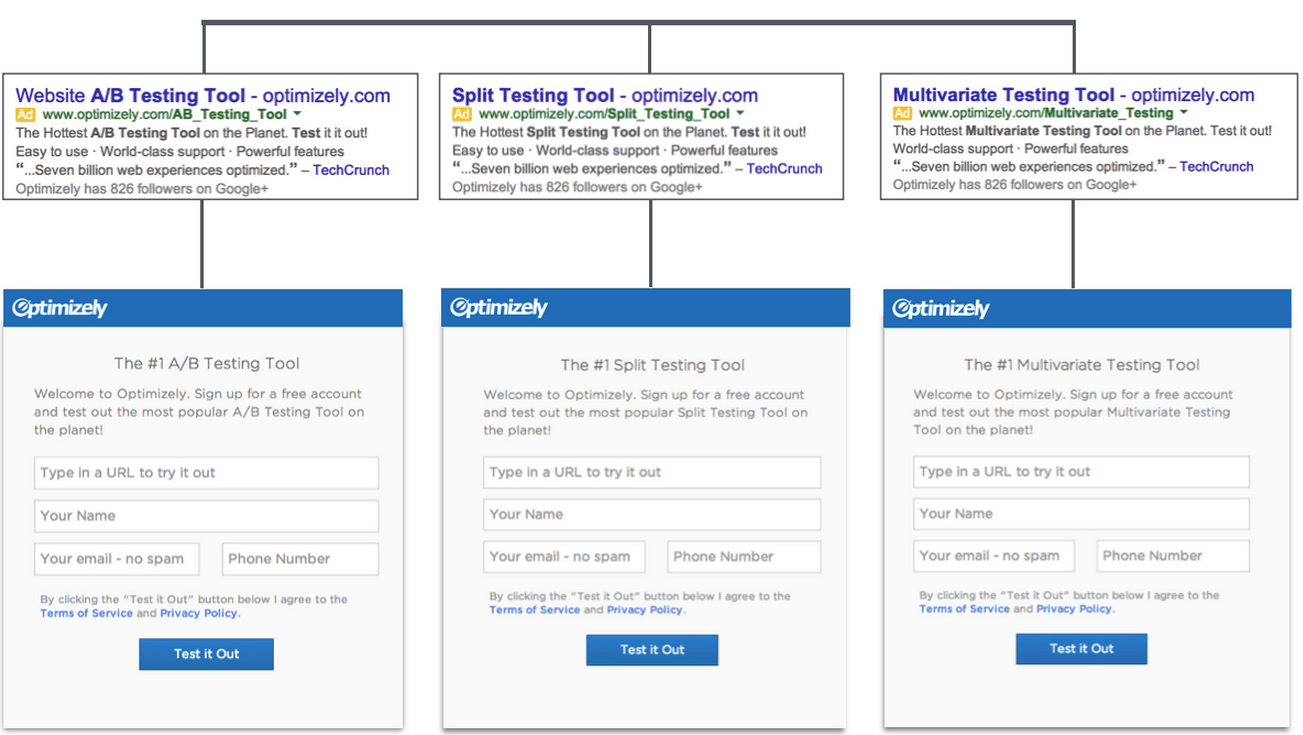Integrating CRO: How to Ensure Conversion Rate Optimisation and PPC Work Together

By Luke Hay|20 Apr 2015
No digital marketing channel performs to its full potential in isolation. Any digital marketer will tell you the most successful campaigns feature multiple channels working together to achieve the same objective.
Conversion rate optimisation (CRO) is no exception to this rule. In the second blog post of our Integrating CRO series, we look at how to run your CRO campaigns to best complement your PPC work.
Both disciplines fit together well as they are quite data-driven and require an analytical mindset to get the best results. They also both tend to focus on the same goal: conversions.
PPC and CRO are both ongoing processes that rely on a mixture of expertise, research, analysis and a bit of ‘trial and error’ to find the best strategies for driving conversions. Both should be based on well thought-out hypotheses about how changes made to ads, pages, or whole websites, will affect conversion rates.
How can the two disciplines complement each other?
As the impact of CRO and PPC is generally more measurable than other digital disciplines, it’s often easier to work out a return on investment (ROI). Both can benefit from small changes and they both focus on continual optimisation to improve performance. Because of this, it is important that the two disciplines work closely together to share their insights and to ensure that campaigns are planned in a way which benefits them both.
Shared knowledge
Both use the same measurement metrics, often focusing on conversions and revenue rather than traffic. This means there can be a lot of shared knowledge between the two. For example, if PPC ads that include ’best car insurance' perform better than those that use ’cheapest car insurance‘, this can feed into tests to change this messaging on the site, and vice versa.
The fact that PPC and CRO are both conversion-led means that practitioners often have similar mindsets. They both need a good understanding of the target audience and what is likely to convince them to make a purchase. Knowledge of users can be shared so that both PPC ads and websites can be targeted in the right way. Understanding the customer is important for both, while knowing the right language and the right type of content/offering is also crucial.
Nate Wood, head of biddable media at Fresh Egg, gives his thoughts on how PPC and CRO can work well together:
‘In my opinion, CRO is not just important but critical to the digital process. The quickest way to improve a digital advertising campaign is to look at the conversion rate of a site and see if that can be improved. If the conversion rate is maximised then results can be improved before traffic optimisation even begins. This leads to a better cost-per-acquisition (CPA), meaning that we have more room within targets to expand the activity.
‘It's vital there is no disjoint in the user journey, particularly for commercial journeys, and that's something that has always been a consideration of biddable media. We've always had to consider the user's journey, and their intent, and CRO is a natural extension of this. Split testing is an integral part of what we do and there are lots of synergies between the two disciplines.
‘The overall user experience of a landing page is an important part of Quality Score within PPC campaigns, which has a big impact on where our ads are shown. This means that onsite factors are a big consideration for us, as well as the content of our ads.’
Analytics
Analytics also plays a big part in CRO and PPC. While an understanding of users, and a fair bit of creativity, is required, knowledge of numbers is also vital for both disciplines.

PPC and CRO are both data-driven, so make sure you share the analytics
The wealth of data produced by running CRO and PPC campaigns should be shared as there is a lot that can be learned from this.
Consistent traffic
PPC can be used to drive more traffic to an A/B test. Tests can take a long time to reach a statistically significant conclusion if there is a low level of traffic to a site; a well-run PPC campaign with a good budget can drive traffic and help tests reach a conclusion in less time.
PPC traffic is also more consistent than other traffic types. SEO traffic, for example, will come from a wide range of keywords, some more relevant than others. In contrast, PPC keywords will be more targeted and relevant, meaning traffic from paid ads will be likely to convert at a more consistent rate than SEO, social or referral traffic.
Increasing conversions
Good CRO can bring massive benefits to PPC campaigns. By increasing the conversion rate it means that PPC budget can go further, as the CPA will be reduced. This can mean that more budget is available for increased bids on competitive terms. An engaging and relevant landing page that matches the user’s intent will also improve the Quality Score of ads, meaning that they may gain better visibility as a result.
Symmetry
Ideally there should be a strong symmetry between PPC adverts and landing pages. CRO gives a good opportunity to ensure that the two work in harmony. Optimizely has seen some real success from this approach. In its test, the headline of the page mirrored the paid search ad the user had clicked through from.
For example, if the search ad said ’A/B testing tool‘, the headline on the landing page would also say ’A/B testing tool’. If the search ad said ’Split testing tool‘, the headline would say ’Split testing tool’.

This symmetric messaging approach led to a massive 39.1% increase in conversions from visitors to leads, an impressive result indeed.
What are the challenges?
There are a lot of areas of consideration when running simultaneous PPC and CRO campaigns. While the two can work well together, they can also cause each other problems if the campaigns are run in silos.
Destination pages
While it’s great when there’s symmetry between PPC adverts and landing pages (as covered in the above example from Optimizely), you need to be very wary of A/B tests causing pages to become irrelevant to ads.
If the wording for an ad suggests one thing, but the landing page says another, this will most likely lead to poor conversion rates. This can be a particular problem if an A/B test is being run on a PPC landing page where the two variations are very different. It may be difficult to ensure that the messaging in the PPC ad is applicable to both variations.
Some PPC landing pages are specifically created for the purpose of gaining quick conversions, meaning that they may sit outside the rest of the site. This could prevent the traffic from those ads being entered into A/B tests, which means the tests would have to run for longer to see a statistically significant result.
Consistent messaging
Changing the messaging of PPC ads that send traffic to pages running A/B tests may skew the results of those tests.

Make sure your PPC messaging is consistent during CRO campaigns
PPC is quite agile and the messaging of adverts can be changed regularly. This can be a challenge, as A/B tests are often run over longer periods. This makes it difficult to run successful PPC campaigns to a particular landing page, while accurately tracking the performance of an A/B test running on the same page.
Differing results
While it is useful to share learnings between PPC and CRO, it should be remembered that a technique that works for one may not work for the other. One example is an Optimizely test run on the website’s PPC ads. Onsite, CRO campaigns can show that using pictures of people is often a good way to improve conversions. However, Optimizely found this was not the case for its paid adverts:
“Interestingly, we discovered that users responded negatively to banners featuring images of people – in every single instance, banners featuring people performed poorly compared to more graphical banners. This isn’t something we could have predicted without testing!”
Biased traffic
The traffic from PPC will be quite biased. The best PPC adverts will include positive persuasive language to ensure the user is already thinking about making a purchase before they arrive on the website. Traffic from other sources is more inconsistent and some of this traffic will inevitably be made up of people who have no desire to convert. This is not necessarily a problem, but it’s something that needs to be considered when planning an A/B test.
When looking at the results of A/B tests, it is important to segment the audience to see how different groups reacted to the different variations. Segmenting to view traffic from paid search will enable you to see how these visitors behaved compared to those who came via other traffic sources.
Summary
PPC and CRO can work well together to improve the number of conversions. Each discipline can inform the other to ensure that the most targeted traffic and tests are being achieved. Both are data-driven and both require in-depth knowledge of their audiences to deliver a great targeted experience.
If the two work in silos, this can cause problems for a site, as A/B testing can lead to PPC landing pages, which seem ‘off-message’ and PPC campaigns can deliver very skewed traffic. This is why we work closely with the biddable media team here at Fresh Egg to ensure that we learn from each other and produce great results.
Find out more about our conversion rate optimisation and PPC services.